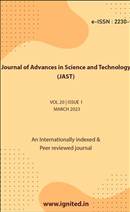A Study of the Prospects and Challenges of India's Government Social Rental Housing
DOI:
https://doi.org/10.29070/aw8c1n20Keywords:
Social Rental Housing, Government, Urban India, Housing SchemesAbstract
This research explores into the complex world of social rental housing schemes run by the Indian government, looking at its prospective & challenges. It is the responsibility of the government to provide "housing for all," as this is a right incorporated in the Constitutional Directive Principles of State Policy. Social rental housing is a subset of rental housing that aims to include more people. In response, the government of India has launched several social rental housing initiatives to make affordable, good housing available to everybody. Essential components in reducing housing disparity, it assesses how well these programs foster social inclusion & sustainable urban development. Until recently, the topic of rental housing in India was mostly ignored. With the fact that there are 21.72 million urban rented houses, no legislative framework has been put in place to encourage private sector involvement in this crucial subset of housing, even though the country has been independent for 72 years.
Downloads
References
Agarwal, A, V Jain and A Karamchandani (2013): “State of the Low-income Housing Market: Encouraging Progress and Opportunity to Realise Dreams of Millions,” Report, July, Mumbai: Deloitte Touche Tohmatsu India Private Limited.
Ashar, S (2013): “FSI Lowered as Rental Housing Scheme Fails,” Times of India, Mumbai, 26 April, retrieved from http://timesofindia.indiatimes. com/city/mumbai/FSI-lowered-as-rental-housing-scheme-fails/articleshow/19731707.cms.
Bhan, G. and A Jana (2013): “Of Slums or Poverty: Notes of Caution from Census 2011,” Economic & Political Weekly, Vol XLVIII, No 18, pp 13–16.
Blanchfl, D G and A J Oswald (2013): Does High Home-Ownership Impair the Labor Market? Peterson Institute for International Economics.
Census of India (2011): HH-4: Slum Households by Ownership Status of the Census Houses, Size of the Household and Number of Dwelling Rooms, New Delhi.
D’Mello, A and C Tembhekar (2008): “Low-Cost Hsg: MMRDA Chief Pushes for BDD Chawl Model,” Times of India, Mumbai, 13 October, p 10, retrieved from http://epaper.timesofi ndia.com/Repository/ml.asp?Ref=VE9JTS8yMD A4LzEwLzEzI0FyMDEwMDE=&Mode=HTML.
Dev, S and P D Dey (2006): Rent Control Laws in India: A Critical Analysis (No. NIUA WP 06-04) New Delhi, retrieved from http://niua.org/ Publications/working_papers/Paper Rent Control Laws_Satvik.pdf.
Gandhi, S, V Tandel, S Patel, A Pethe, K Agarwal and S J Libeiro (2014): “Decline of Rental Housing in India: A Case Study of Mumbai,” Working Paper, Marron Institute of Urban Management, New York University.
Government of Maharashtra (2008a): Final Notification on Modification of the Maharashtra Town and Country Planning Act 1966 for Incorporating MMRDA Rental Housing Scheme (26 November), Urban Development Department, Government of Maharashtra, Mumbai. —
Government of Maharashtra (2008b): MRTP Act 1966: Modifications of DCR of Greater Mumbai (6 August), Urban Development Department, Government of Maharashtra, Mumbai. —
Government of Maharashtra (2008c): MRTP Act 1966: Modifications of DCRs of Municipal Councils of Karjat, Pen, Uran, Alibagh and Khopoli, 21 August, Urban Development Department, Government of Maharashtra, Mumbai. —
Government of Maharashtra (2008d): MRTP Act 1966: Modifications of DCRs of Thane, Kalyan–Dombivali, Mira–Bhayander, Bhiwandi–Nizampur and SPA Areas at Vasai– Virar sub-region and Ambernath, Kulgaon, Badlapur and Surrounding Notifi ed and MC of Panvel (4 November), Urban Development Department, Government of Maharashtra, Mumbai. —
Government of Maharashtra (2008e): Notice to Modify DCRs of Planning Areas under MMR (20 August), Urban Development Department, Government of Maharashtra Mumbai. —
Government of Maharashtra (2009): MRTP Act 1966: Modifications of DCR of Municipal Corporation of Ulhasnagar (25 August), Urban Development Department, Mumbai. —
Haffner, M E A, M Oxley, H Van Der Heijden and J Hoekstra (2009): Bridging the Gap Between Social and Market Rented Housing in Six European Countries, Amsterdam: IOS Press BV.
Harish, S (2015a): Making Rental Housing Work: A Case for Slum Households and ULBs, Administrator, 65(2). —
Harish, S (2015b): MMRDA Rental Housing Scheme. Krishnaprasad (2009): “Has Karnataka Rent Act Become Redundant?,” Hindu, Bengaluru, 12 November, retrieved from http://www.thehindu. com/todays-paper/tp-national/tp-karnataka/ has-karnataka-rent-act-become-redundant/article138036.ece.
Kumar, S (2001): Social Relations Rental Housing Markets and the Poor in Urban India, London: DFID.
MMRDA (2011): “Mumbai Metropolitan Region Development Authority Rental Housing Scheme,” Mumbai Metropolitan Region Development Authority, Mumbai.
MoHUPA (2012): Report of the Technical Group on Urban Housing Shortage (TG 12) 2012–17, Ministry of Housing and Urban Poverty Alleviation, New Delhi, retrieved from www.mhupa.gov.in. — (2013): Report on Policy and Interventions to Spur Growth of Rental Housing in India, New Delhi. MoSPI (2010a): Housing Condition and Amenities in India 2008–09 (Vol 535).
Priemus, H, F Dieleman and D Clapham (1999): “Current Developments in Social Housing Management,” Netherlands Journal of Housing and the Built Environment, 14(3), 211–23, http:// doi.org/10.1007/BF02496678.
Sengupta, U (2006): Liberalization and the Privatization of Public Rental Housing in Kolkata, Cities, 23(4), 269–78, http://doi.org/10.1016/j. cities.2006.01.003.
Ulekh, N P (2015): “A Place Called Bhatkal,” Open Magazine, April, retrieved from http://www. openthemagazine.com/article/nation/a-place called-bhatkal.






